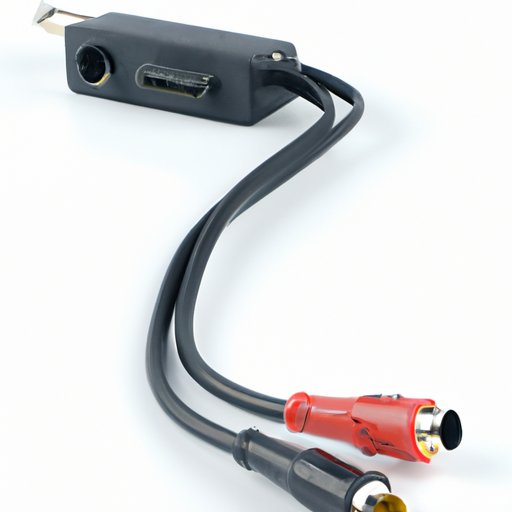Introduction
DVD players are electronic devices that can be used to play DVDs. They are typically connected to a television or other form of monitor so that the user can watch the DVD. Knowing how to hook up a DVD player to a TV is an important skill for anyone wishing to watch DVDs at home. This article will provide an overview of how to hook up a DVD player to a TV, as well as step-by-step instructions on how to do so using different types of cables and wireless technology.
Use an HDMI Cable
HDMI (High Definition Multimedia Interface) cables are the most common type of cable used to connect a DVD player to a TV. HDMI cables provide high quality audio and video signals and are relatively easy to use. The following steps can be used to hook up a DVD player to a TV using an HDMI cable:
- Connect one end of the HDMI cable to the “HDMI OUT” port on the back of the DVD player.
- Connect the other end of the HDMI cable to the “HDMI IN” port on the back of the TV.
- Turn on both the DVD player and the TV.
- Select the correct HDMI input on the TV.
- Insert the DVD into the DVD player.
Connect with Component Cables
Component cables are another option for connecting a DVD player to a TV. Component cables are split into three separate cables – red, green, and blue – and each carries a different signal. Component cables provide higher quality audio and video than composite cables, but they are more expensive and more difficult to use. The following steps can be used to hook up a DVD player to a TV using component cables:
- Connect the red, green, and blue cables from the component cable set to the corresponding “COMPONENT OUT” ports on the back of the DVD player.
- Connect the other ends of the red, green, and blue cables to the corresponding “COMPONENT IN” ports on the back of the TV.
- Turn on both the DVD player and the TV.
- Select the correct component input on the TV.
- Insert the DVD into the DVD player.
Use Composite Video and Audio Cables
Composite video and audio cables are the most basic type of cable used to connect a DVD player to a TV. They are typically color-coded yellow, white, and red and are relatively inexpensive and easy to use. The following steps can be used to hook up a DVD player to a TV using composite video and audio cables:
- Connect the yellow cable from the composite cable set to the “VIDEO OUT” port on the back of the DVD player.
- Connect the white and red cables from the composite cable set to the corresponding “AUDIO OUT” ports on the back of the DVD player.
- Connect the other ends of the yellow, white, and red cables to the corresponding “VIDEO IN” and “AUDIO IN” ports on the back of the TV.
- Turn on both the DVD player and the TV.
- Select the correct video input on the TV.
- Insert the DVD into the DVD player.
Use S-Video Cables
S-Video cables are another type of cable used to connect a DVD player to a TV. They provide better picture quality than composite cables, but not as good as component or HDMI cables. The following steps can be used to hook up a DVD player to a TV using S-Video cables:
- Connect the S-Video cable to the “S-VIDEO OUT” port on the back of the DVD player.
- Connect the other end of the S-Video cable to the “S-VIDEO IN” port on the back of the TV.
- Connect the white and red cables from the composite cable set to the corresponding “AUDIO OUT” ports on the back of the DVD player.
- Connect the other ends of the white and red cables to the corresponding “AUDIO IN” ports on the back of the TV.
- Turn on both the DVD player and the TV.
- Select the correct S-Video input on the TV.
- Insert the DVD into the DVD player.
Utilize Wireless Technology
Wireless technology is another option for connecting a DVD player to a TV. Wireless technology removes the need for cables and makes it easier to connect a DVD player to a TV. The following steps can be used to hook up a DVD player to a TV using wireless technology:
- Connect the wireless transmitter to the “VIDEO OUT” port on the back of the DVD player.
- Connect the wireless receiver to the “VIDEO IN” port on the back of the TV.
- Turn on both the DVD player and the TV.
- Select the correct video input on the TV.
- Insert the DVD into the DVD player.
Conclusion
Hooking up a DVD player to a TV is a relatively simple process, but it is important to understand the different types of cables and wireless technology available in order to ensure a successful connection. This article provided an overview of how to hook up a DVD player to a TV, as well as step-by-step instructions on how to do so using different types of cables and wireless technology. To ensure a successful connection, it is important to make sure all cables are securely connected and all settings are correctly configured before inserting the DVD into the DVD player.


